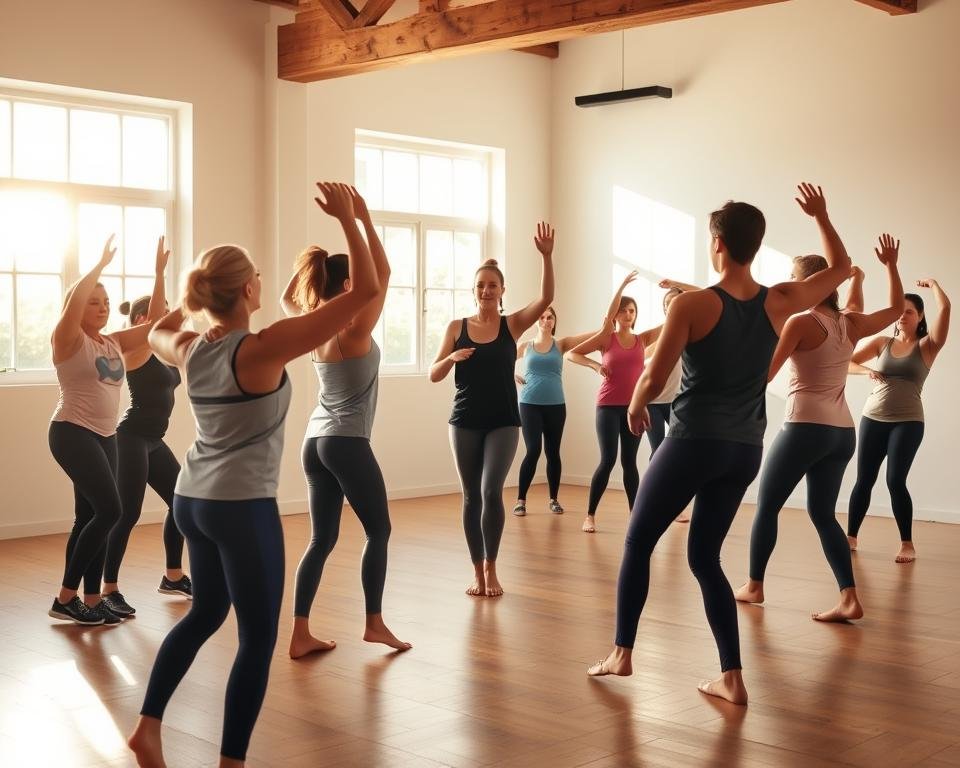Starting my journey to a healthier life, I learned the importance of exercise basics. Fitness is more than just working out. It’s about living a lifestyle that boosts your overall health.
Adding simple yet effective techniques to my daily life helps me reach my health goals. This means staying active, eating well, and getting enough sleep.
Key Takeaways
- Understanding the basics of exercise is key for a healthy life.
- Living a balanced life improves your overall well-being.
- Simple techniques can be added to your daily routine.
- Regular exercise is important for staying healthy.
- Eating right and getting enough sleep are also critical.
Understanding Fitness Basics
The journey to physical wellness starts with knowing the basics of fitness. To make good workout routines, it’s key to understand what fitness is and its parts.
What is Fitness?
Fitness means being healthy and feeling good through exercise, eating right, and resting enough. It’s not just about looking good; it’s about heart health, muscle strength, endurance, and being flexible. Being fit helps me do daily tasks better and lowers the risk of long-term diseases.
Different Types of Fitness
There are many types of fitness, like heart health, muscle strength, flexibility, and balance. Cardiovascular fitness means doing activities that make my heart rate go up and improve my heart. Muscular fitness comes from strength training, which builds muscle and speeds up my metabolism. Flexibility is about moving better, and balance helps me avoid falls and injuries.
The Importance of Physical Activity
Physical activity is key to fitness. Exercise keeps me at a healthy weight, boosts my mood, improves sleep, and gives me more energy. It also lowers the risk of diseases like diabetes, heart disease, and some cancers. By adding physical activity to my daily life, I can greatly improve my health.
Setting Realistic Fitness Goals
Setting achievable fitness goals is key to a good workout routine. When I set realistic goals, I stay motivated and track my progress well.
Short-term vs. Long-term Goals
It’s important to know the difference between short-term and long-term goals. Short-term goals are quick wins, like doing a certain number of workouts or losing a few pounds. Long-term goals are bigger, like losing a lot of weight or running a marathon.
SMART Goal Framework
I use the SMART goal framework to make my goals effective. SMART means Specific, Measurable, Achievable, Relevant, and Time-bound. My goals should be clear, measurable, and have a deadline.
For example, instead of “I want to lose weight,” a SMART goal is “I will lose 10 pounds in 3 months by exercising 30 minutes, 3 times a week.”

Tracking Your Progress
Tracking my progress is key to reaching my fitness goals. I monitor my workouts and follow nutrition tips for weight loss strategies. Keeping a workout log and journaling my diet helps me see patterns and make changes.
Using technology like fitness apps and wearables also helps. They give me insights into my performance and keep me motivated.
Strength Training Essentials
Adding strength training to my workouts has changed my fitness game. It’s not just about getting bigger muscles. It’s about getting healthier and feeling better overall.

Benefits of Strength Training
Strength training brings many benefits. It helps build muscle, strengthen bones, and boost metabolism. It also improves my posture and lowers injury risk. By adding strength training, I get a stronger, healthier body.
Different Types of Strength Exercises
There are many strength exercises I can try. These include:
- Weightlifting: Using free weights or machines to work my muscles.
- Bodyweight exercises: Using my body weight for resistance, like push-ups and squats.
- Resistance band exercises: Using elastic bands for resistance.
How to Start Strength Training
To start, I need to set clear goals and maybe talk to a fitness pro. I should start with light weights and slowly get stronger. It’s key to focus on proper form to avoid injuries. A good strength training plan helps me reach my fitness goals.
Cardiovascular Fitness Techniques
I’ve learned how key cardiovascular fitness is for my health. It keeps my heart strong and boosts my overall well-being. Adding cardio workouts to my routine helps my heart, increases my stamina, and supports a healthy lifestyle.

Understanding Cardio Workouts
Cardio workouts make my heart rate go up and improve my heart, lungs, and blood flow. These can be anything from walking fast to running or cycling.
Benefits of Cardio Workouts:
- Improved heart health
- Increased lung capacity
- Enhanced endurance
- Weight management
- Reduced risk of chronic diseases
Interval Training Basics
Interval training mixes high-intensity exercise with rest or low-intensity periods. It works for many activities like running, cycling, or swimming.
Key Components of Interval Training:
- Warm-up: Starting with a gentle activity to prepare my muscles
- High-Intensity Intervals: Short bursts of vigorous exercise
- Recovery Intervals: Periods of rest or low-intensity exercise
- Cool-down: Ending with a gentle activity to help my body recover
Choosing the Right Cardio Activity
It’s important to pick the right cardio activity for my workouts. I think about my goals, what I like, and what I can do.
Popular Cardio Activities:
- Running or jogging
- Cycling or spin classes
- Swimming or water aerobics
- Dancing or Zumba
- High-Intensity Interval Training (HIIT)
Flexibility and Stretching
I’ve learned that flexibility is more than just touching my toes. It’s key for physical wellness. Exploring fitness, I see how flexibility boosts my workouts.
Flexibility exercises help me move better and prevent injuries. Stretching daily improves my fitness and performance in other areas.
Why Flexibility Matters
Flexibility keeps me healthy and moves me freely. It also helps my posture and reduces muscle soreness. Plus, it boosts my athletic skills.
Flexibility stops injuries. When muscles are flexible, they’re less likely to get hurt. This is great for those who are active.
Key Benefits of Flexibility:
- Improved range of motion
- Reduced muscle tension
- Enhanced athletic performance
- Injury prevention
Effective Stretching Techniques
I use several stretching methods in my workouts. Static stretching, where I hold a stretch, is common. Dynamic stretching, moving joints, is also helpful.
| Stretching Technique | Description | Benefits |
|---|---|---|
| Static Stretching | Holding a stretch for 15-30 seconds | Improves flexibility, reduces muscle tension |
| Dynamic Stretching | Moving joints through a range of motion | Prepares muscles for exercise, improves flexibility |
Incorporating Flexibility into Workouts
I add flexibility exercises to my workouts. I stretch before and after, and set aside days for flexibility training.
By focusing on flexibility, I boost my wellness and fitness. Good flexibility is key for reaching my fitness goals, whether in strength or cardio.
Nutrition’s Role in Fitness
Achieving fitness goals isn’t just about exercise; nutrition plays a vital role too. A well-planned diet supports my workouts and aids in recovery. It’s a key part of my fitness strategy.
Building a Balanced Diet
To build a balanced diet, I focus on eating a variety of foods. This includes:
- Lean Proteins: Essential for muscle repair and growth.
- Whole Grains: Provide sustained energy throughout the day.
- Fruits and Vegetables: Rich in vitamins, minerals, and antioxidants.
- Healthy Fats: Support heart health and satisfy hunger.
By eating these foods, my body gets the nutrients it needs to reach my fitness goals.

Pre- and Post-Workout Nutrition
Nutrition before and after workouts is critical for performance and recovery. Here are some tips:
- Pre-Workout: Eat a balanced meal with carbs and protein 1-2 hours before. This gives energy and prevents muscle damage.
- Post-Workout: Refuel with carbs and protein within 30-60 minutes after. This helps with muscle recovery and replenishes energy.
Supplements: Do You Need Them?
While a balanced diet is key, supplements can fill nutritional gaps. Common supplements include:
- Protein Powder: Convenient for meeting daily protein needs, post-workout.
- Creatine: Boosts strength and endurance during intense activities.
- Multivitamins: Make sure I get all essential vitamins and minerals.
It’s important to talk to a healthcare professional before adding supplements. This ensures they fit with my fitness goals and health.
Importance of Recovery
Understanding recovery is key to your fitness journey. It’s not just sitting back; it’s an active part of working out. It helps your body fix and get stronger.
When I work out, I build muscle and improve my heart health. But I also hurt my muscles and use up energy. Recovery is when my body fixes these issues and gets ready for more challenges.

Rest Days Explained
Rest days are vital for recovery. They let my body fix and grow muscle, making it stronger. Without enough rest, I might overtrain, which hurts my performance and increases injury risk.
Rest days aren’t just about doing nothing; they can include light yoga or a walk. These activities help with muscle repair and improve flexibility.
Techniques for Effective Recovery
There are many ways to boost recovery. These include:
- Stretching: Helps with flexibility and lessens muscle soreness.
- Foam Rolling: Reduces muscle tension and boosts blood flow.
- Proper Nutrition: Feeds my body the right foods for recovery.
- Adequate Sleep: Crucial for full recovery and health.
Listening to Your Body
Listening to my body is key in recovery. If I’m tired or in pain, I need to slow down. Ignoring these signs can cause serious problems, like chronic injury or burnout.
By focusing on recovery and listening to my body, I can keep exercising well. This helps me stay healthy and reach my fitness goals.
Fitness for Different Age Groups
Creating fitness plans for different ages can make workouts better and safer. As people get older, their exercise needs change. This means they need to adjust their workouts.

Kids and Fitness
For kids, fitness is about building good habits and skills. Playing games like tag or soccer is fun and keeps them active. It’s key to get kids to try many sports and activities.
- Encourage team sports to help with social skills and teamwork.
- Try activities like gymnastics or dance for flexibility and coordination.
- Reduce screen time and encourage outdoor play.
Fitness in Your 30s and 40s
In their 30s and 40s, people often face big changes like work and family. Staying active helps with stress and health.
Key considerations include:
- Do a mix of cardio and strength training to keep muscles and heart healthy.
- Add flexibility and stretching to improve movement.
- Change workouts to fit any physical changes or injuries.
Senior Fitness Considerations
As people get older, their goals change to stay functional and manage health. Seniors should focus on exercises that boost balance, flexibility, and strength.
- Do low-impact activities like walking or swimming to keep the heart healthy without too much strain.
- Use light weights or bands for strength training to keep muscles.
- Do balance exercises like standing on one foot to lower fall risk.
Knowing the special fitness needs of different ages helps make workouts better and safer. This way, people can stay healthy and feel good.
Group Fitness vs. Solo Workouts
I’m always thinking about whether to do group fitness or solo workouts. Each has its own good points. The best choice depends on what I like, my fitness goals, and my situation.
Benefits of Working Out in Groups
Working out with others can really boost my motivation. The group’s energy and friendship make it fun. Plus, group fitness classes offer a set plan, which is great for those who like routine.
Some big pluses of group fitness are:
- It’s fun to be with others and get support
- The group and instructor help motivate me
- It keeps my workouts fresh and exciting

Advantages of Solo Training
But solo workouts offer flexibility and a personal touch. I can pick exercises that really help me, and I can work out whenever I want.
Some good things about solo workouts are:
- I can plan my workouts to fit my schedule
- I can make my exercises match my goals
- I can work out at home or in private
Finding the Right Balance
It’s not always a choice between group or solo workouts. Many people mix both for the best results. For example, I might join group classes a few times a week for motivation. Then, I’ll do solo workouts to focus on certain goals or when it’s convenient.
To lose weight effectively, whether in groups or alone, I need to be consistent and patient. A balanced mix of exercise and healthy eating is key.
Fitness Technology and Apps
Technology has changed how we think about fitness and health. Now, we can track our progress and stay motivated. We can also make our workouts better than ever.
Popular Fitness Tracking Apps
Many fitness apps are popular because they are easy to use. They have lots of features. Some top apps are:
- MyFitnessPal for calorie tracking
- Strava for running and cycling
- Nike Training Club for workout routines
These apps help me reach my fitness goals.
Wearable Technology Overview
Wearable tech has gotten a lot better. It helps us track our health. Devices like Fitbits and Apple Watches let us check our heart rate and steps. They also track our sleep.
How Tech Can Enhance Your Workouts
Technology can make our workouts better in many ways:
- Personalized training plans based on our goals and progress
- Real-time feedback during exercise
- Data analysis to find areas for improvement
This makes our workouts more fun and effective.
| Device | Key Features | Price |
|---|---|---|
| Fitbit Charge | Heart rate monitoring, sleep tracking | $149 |
| Apple Watch | GPS tracking, workout tracking, heart rate monitoring | $299 |
| Garmin Forerunner | GPS running dynamics, heart rate monitoring | $200 |
Using these tools in our fitness routine helps us live healthier. It makes our workouts more balanced and effective.
Staying Motivated
Keeping motivated is key to lasting fitness success. By adding effective workouts to my daily routine, I boost my physical health. This helps me reach my goals.
Practical Tips for Sustained Motivation
To stay motivated, I set reachable goals and track my progress. This keeps me on track with my fitness journey. I also pay attention to my diet, as it fuels my workouts and keeps me healthy.
Breaking Through Fitness Plateaus
When I hit a fitness plateau, I look at my workouts and make changes. This might mean trying new exercises or working out harder. These steps help me get past the hurdle and keep moving forward.
Cultivating a Positive Mindset
Having a positive mindset is vital for staying motivated. I focus on the good things about working out, like better health. I also celebrate my wins to keep myself going.
FAQ
What are the most effective strength training exercises for beginners?
For beginners, start with squats, lunges, push-ups, and rows. These exercises work many muscles and are key for a strong start. Adding strength training to your routine boosts your overall health.
How often should I do cardio workouts to improve cardiovascular health?
Do cardio workouts three to four times a week. Mix steady-state cardio with interval training. This boosts your heart health and supports a healthy lifestyle.
What are some tips for setting realistic fitness goals?
Use the SMART goal framework for setting goals. Make sure they are specific, measurable, achievable, relevant, and time-bound. Track your progress to stay motivated and adjust your routine as needed.
How important is nutrition in achieving fitness goals?
Nutrition is key in my fitness journey. Eat a balanced diet with protein, complex carbs, and healthy fats. Focus on pre- and post-workout nutrition to improve performance and recovery.
Can I achieve weight loss through strength training alone?
Strength training builds muscle, but for weight loss, combine it with cardio and a healthy diet. Muscle boosts your metabolism, aiding in weight loss.
How can I stay motivated to continue my workout routine?
Mix up your workouts and try new exercises. Track your progress and work out with friends or join groups. This keeps you accountable and motivated.
What are some effective recovery techniques after a workout?
Prioritize recovery with stretching, foam rolling, and rest days. Listen to your body and take extra rest if needed.
Are supplements necessary for fitness?
Supplements can help, but a balanced diet is most important. Always consult a healthcare professional before adding supplements to your routine.
How can I incorporate flexibility and stretching into my workout routine?
Include stretching exercises after workouts, focusing on major muscle groups. Add flexibility exercises like yoga or Pilates to improve flexibility and range of motion.







